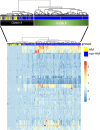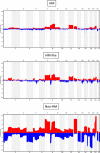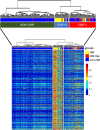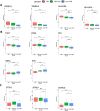An integrative in-silico analysis discloses a novel molecular subset of colorectal cancer possibly eligible for immune checkpoint immunotherapy
- PMID: 35534873
- PMCID: PMC9082922
- DOI: 10.1186/s13062-022-00324-y
An integrative in-silico analysis discloses a novel molecular subset of colorectal cancer possibly eligible for immune checkpoint immunotherapy
Abstract
Background: Historically, the molecular classification of colorectal cancer (CRC) was based on the global genomic status, which identified microsatellite instability in mismatch repair (MMR) deficient CRC, and chromosomal instability in MMR proficient CRC. With the introduction of immune checkpoint inhibitors, the microsatellite and chromosomal instability classification regained momentum as the microsatellite instability condition predicted sensitivity to immune checkpoint inhibitors, possibly due to both high tumor mutation burden (TMB) and high levels of infiltrating lymphocytes. Conversely, proficient MMR CRC are mostly resistant to immunotherapy. To better understand the relationship between the microsatellite and chromosomal instability classification, and eventually discover additional CRC subgroups relevant for therapeutic decisions, we developed a computational pipeline that include molecular integrative analysis of genomic, epigenomic and transcriptomic data.
Results: The first step of the pipeline was based on unsupervised hierarchical clustering analysis of copy number variations (CNVs) versus hypermutation status that identified a first CRC cluster with few CNVs enriched in Hypermutated and microsatellite instability samples, a second CRC cluster with a high number of CNVs mostly including non-HM and microsatellite stable samples, and a third cluster (7.8% of the entire dataset) with low CNVs and low TMB, which shared clinical-pathological features with Hypermutated CRCs and thus defined Hypermutated-like CRCs. The mutational features, DNA methylation profile and base substitution fingerprints of these tumors revealed that Hypermutated-like patients are molecularly distinct from Hypermutated and non-Hypermutated tumors and are likely to develop and progress through different genetic events. Transcriptomic analysis highlighted further differences amongst the three groups and revealed an inflamed tumor microenvironment and modulation Immune Checkpoint Genes in Hypermutated-like CRCs.
Conclusion: Therefore, our work highlights Hypermutated-like tumors as a distinct and previously unidentified CRC subgroup possibly responsive to immune checkpoint inhibitors. If further validated, these findings can lead to expanding the fraction of patients eligible to immunotherapy.
Keywords: Colorectal cancer; Immunoinformatics; Immunotherapy; Meta-analysis; Multi-omics.
© 2022. The Author(s).
Conflict of interest statement
The authors declare that they have no competing interests.
Figures







Similar articles
-
Relationships Between Immune Landscapes, Genetic Subtypes and Responses to Immunotherapy in Colorectal Cancer.Front Immunol. 2020 Mar 6;11:369. doi: 10.3389/fimmu.2020.00369. eCollection 2020. Front Immunol. 2020. PMID: 32210966 Free PMC article. Review.
-
Immunotherapy efficacy on mismatch repair-deficient colorectal cancer: From bench to bedside.Biochim Biophys Acta Rev Cancer. 2020 Dec;1874(2):188447. doi: 10.1016/j.bbcan.2020.188447. Epub 2020 Oct 6. Biochim Biophys Acta Rev Cancer. 2020. PMID: 33035640 Free PMC article. Review.
-
A next-generation sequencing-based strategy combining microsatellite instability and tumor mutation burden for comprehensive molecular diagnosis of advanced colorectal cancer.BMC Cancer. 2021 Mar 16;21(1):282. doi: 10.1186/s12885-021-07942-1. BMC Cancer. 2021. PMID: 33726687 Free PMC article.
-
Morphological, immunophenotypical and molecular features of hypermutation in colorectal carcinomas with mutations in DNA polymerase ε (POLE).Histopathology. 2020 Feb;76(3):366-374. doi: 10.1111/his.13984. Epub 2019 Dec 1. Histopathology. 2020. PMID: 31479159
-
Genomic and transcriptomic characterization of heterogeneous immune subgroups of microsatellite instability-high colorectal cancers.J Immunother Cancer. 2021 Dec;9(12):e003414. doi: 10.1136/jitc-2021-003414. J Immunother Cancer. 2021. PMID: 34903553 Free PMC article.
Cited by
-
A comprehensive molecular characterization of a claudin-low luminal B breast tumor.Biol Direct. 2024 Aug 16;19(1):66. doi: 10.1186/s13062-024-00482-1. Biol Direct. 2024. PMID: 39152485 Free PMC article.
-
Effect of colorectal cancer stem cells on the development and metastasis of colorectal cancer.World J Gastrointest Oncol. 2024 Nov 15;16(11):4354-4368. doi: 10.4251/wjgo.v16.i11.4354. World J Gastrointest Oncol. 2024. PMID: 39554751 Free PMC article. Review.
-
Correlation-based network integration of lung RNA sequencing and DNA methylation data in chronic obstructive pulmonary disease.Heliyon. 2024 May 15;10(10):e31301. doi: 10.1016/j.heliyon.2024.e31301. eCollection 2024 May 30. Heliyon. 2024. PMID: 38807864 Free PMC article.
-
Identification of a novel cellular senescence-related lncRNA signature for prognosis and immune response in osteosarcoma.Transl Cancer Res. 2024 Jul 31;13(7):3742-3759. doi: 10.21037/tcr-24-163. Epub 2024 Jul 8. Transl Cancer Res. 2024. PMID: 39145087 Free PMC article.
References
-
- Cancer Statistics, 2021—PubMed. https://pubmed-ncbi-nlm-nih-gov.ezproxy.uniroma1.it/33433946/. Accessed 13 Dec 2021.
-
- Goodman AM, Kato S, Bazhenova L, Patel SP, Frampton GM, Miller V, Stephens PJ, Daniels GA, Kurzrock R. Tumor mutational burden as an independent predictor of response to immunotherapy in diverse cancers. Mol Cancer Ther. 2017;16(11):2598–2608. doi: 10.1158/1535-7163.MCT-17-0386. - DOI - PMC - PubMed
Publication types
MeSH terms
Substances
LinkOut - more resources
Full Text Sources
Medical

